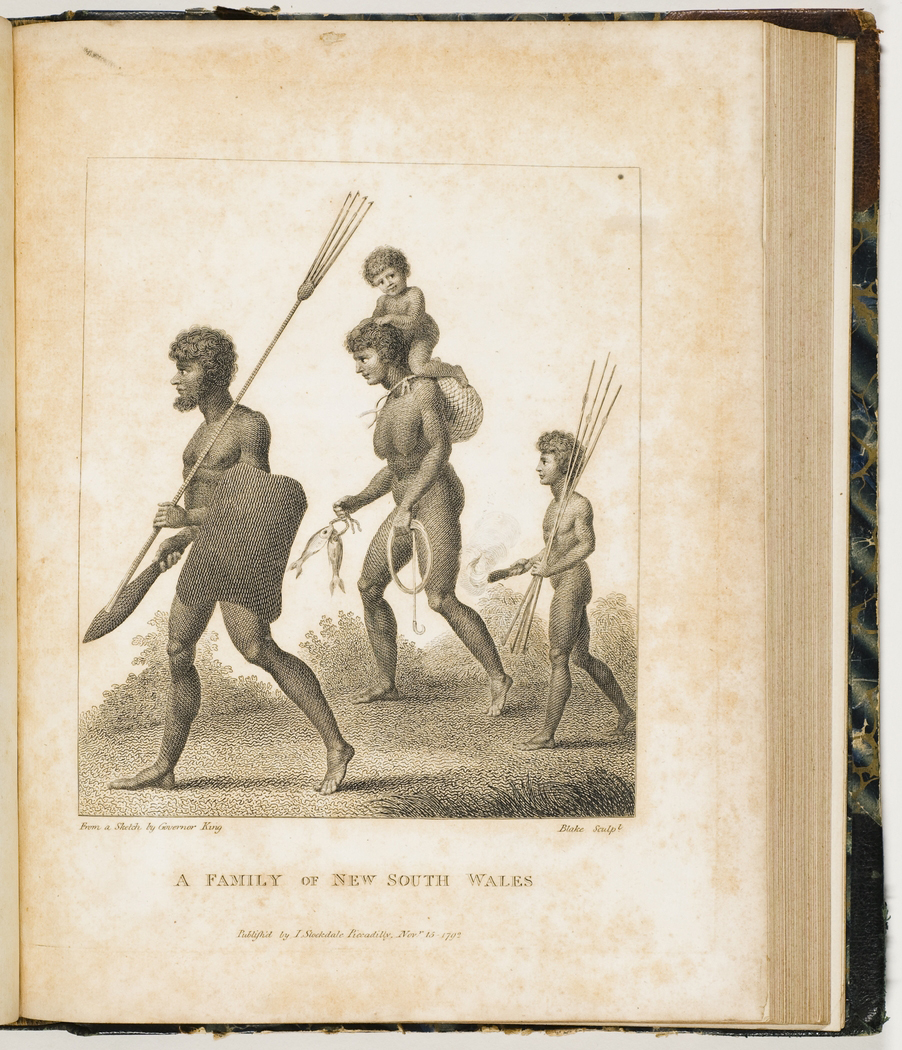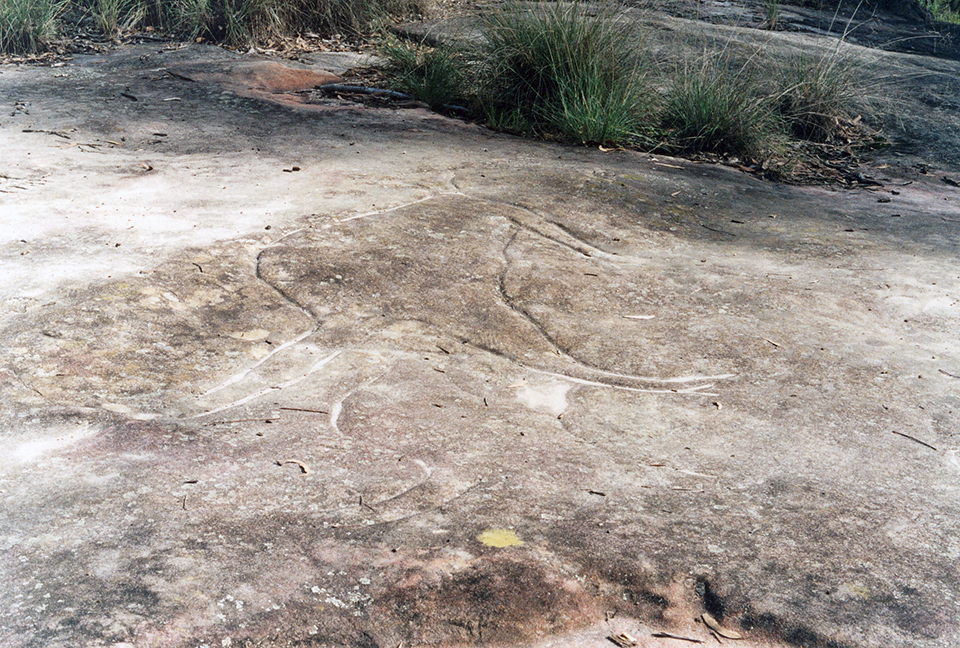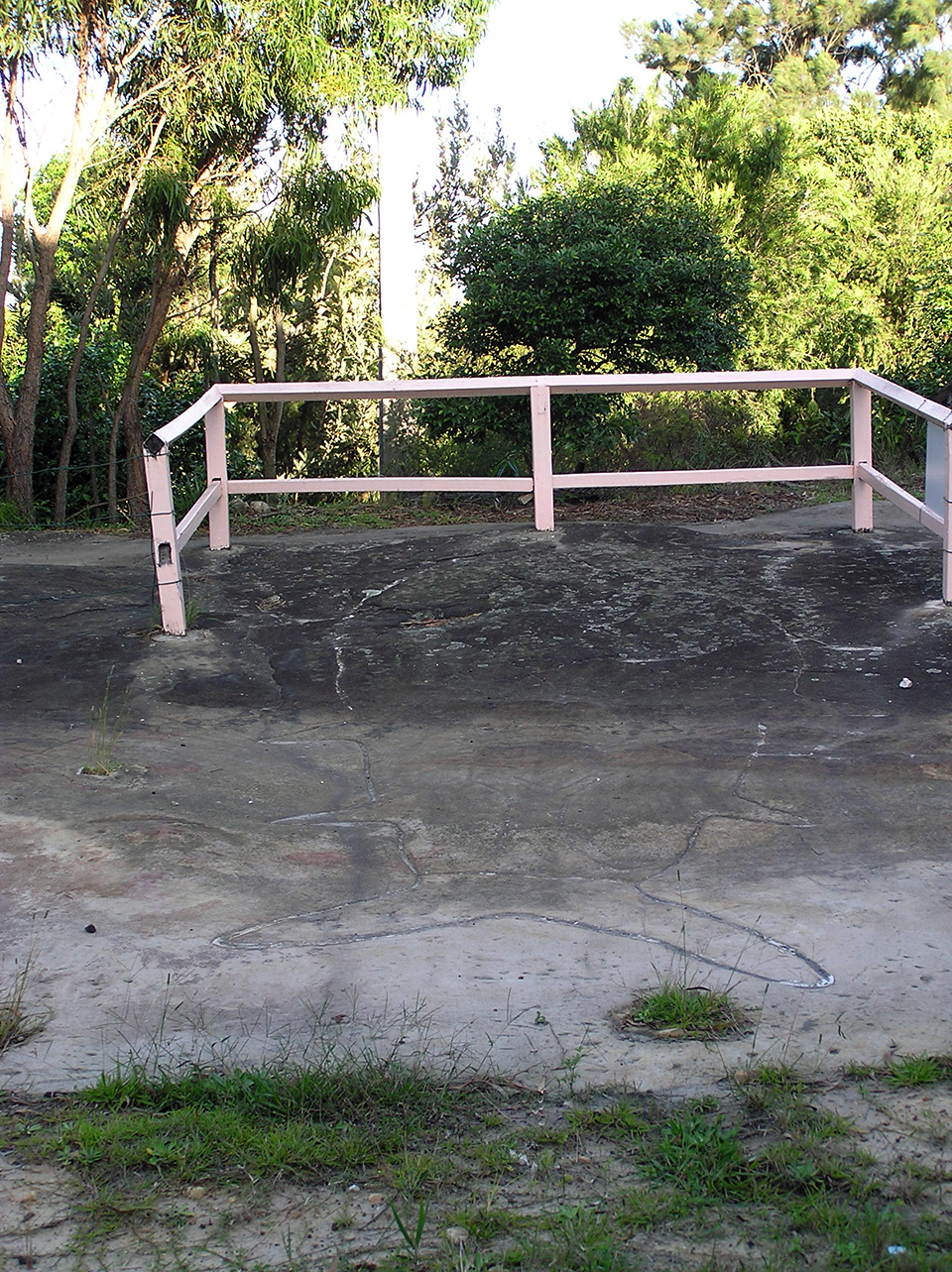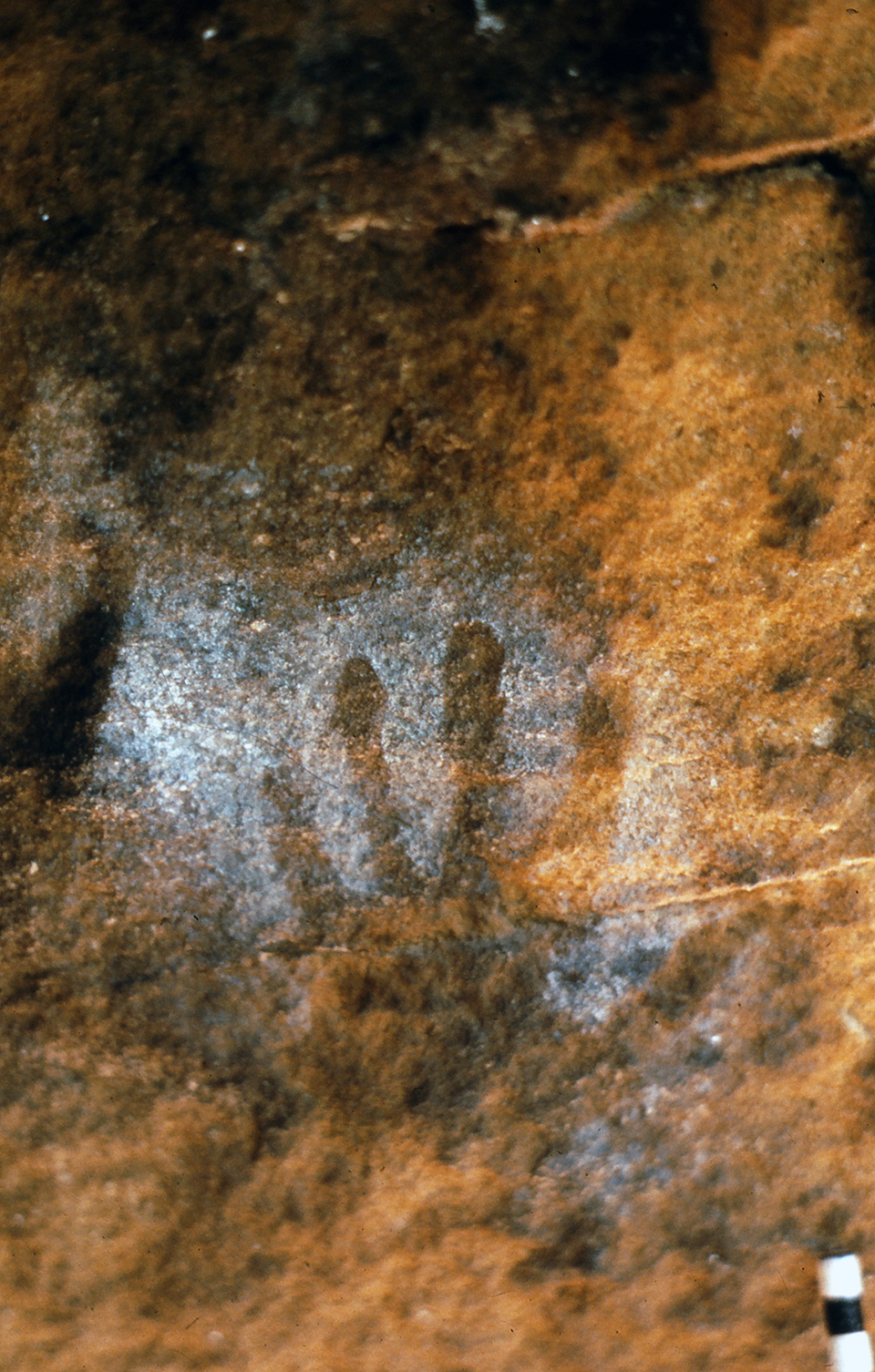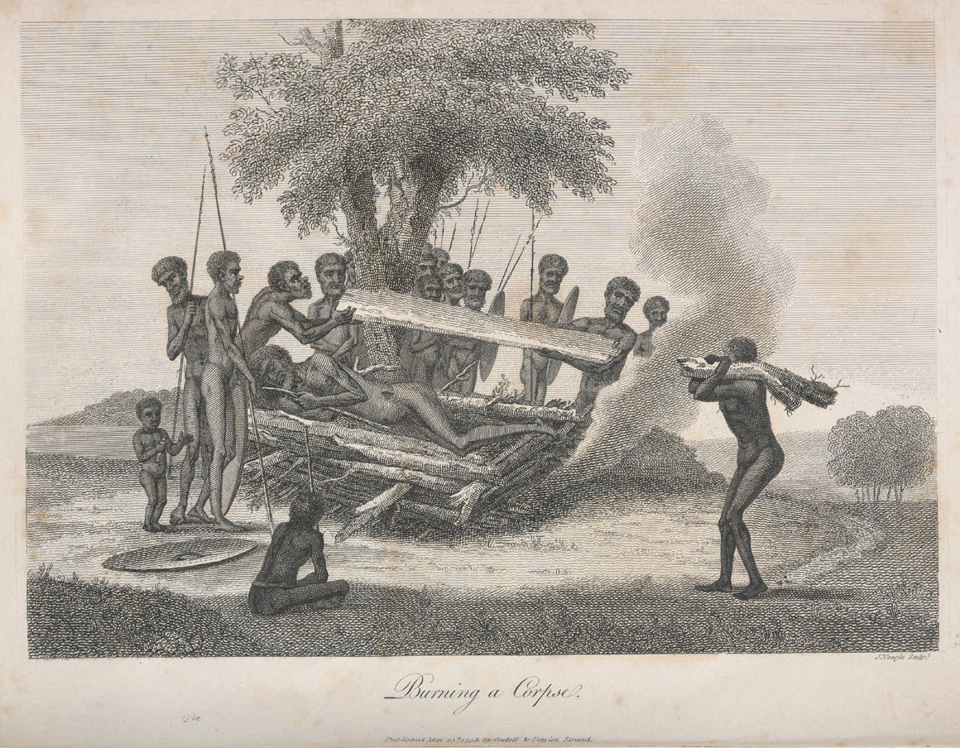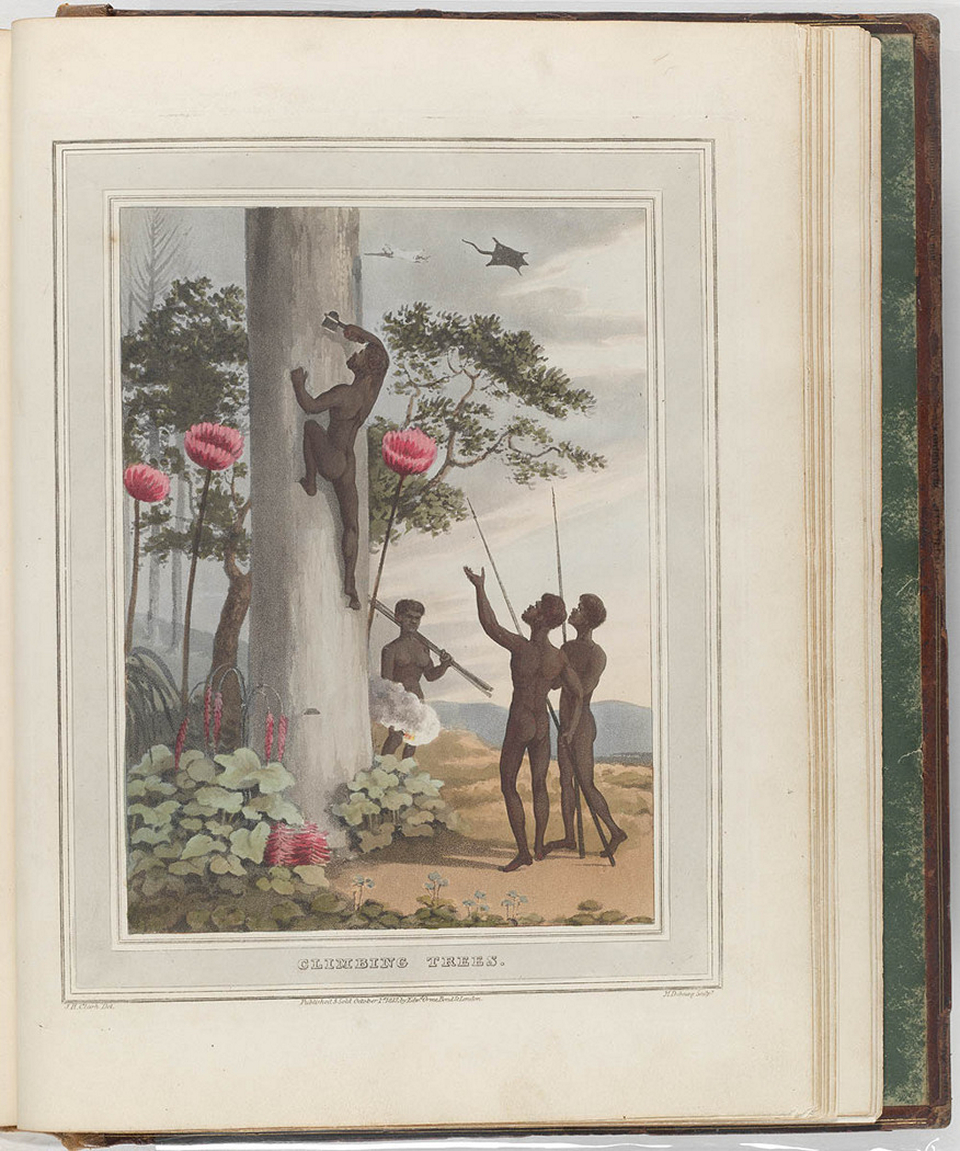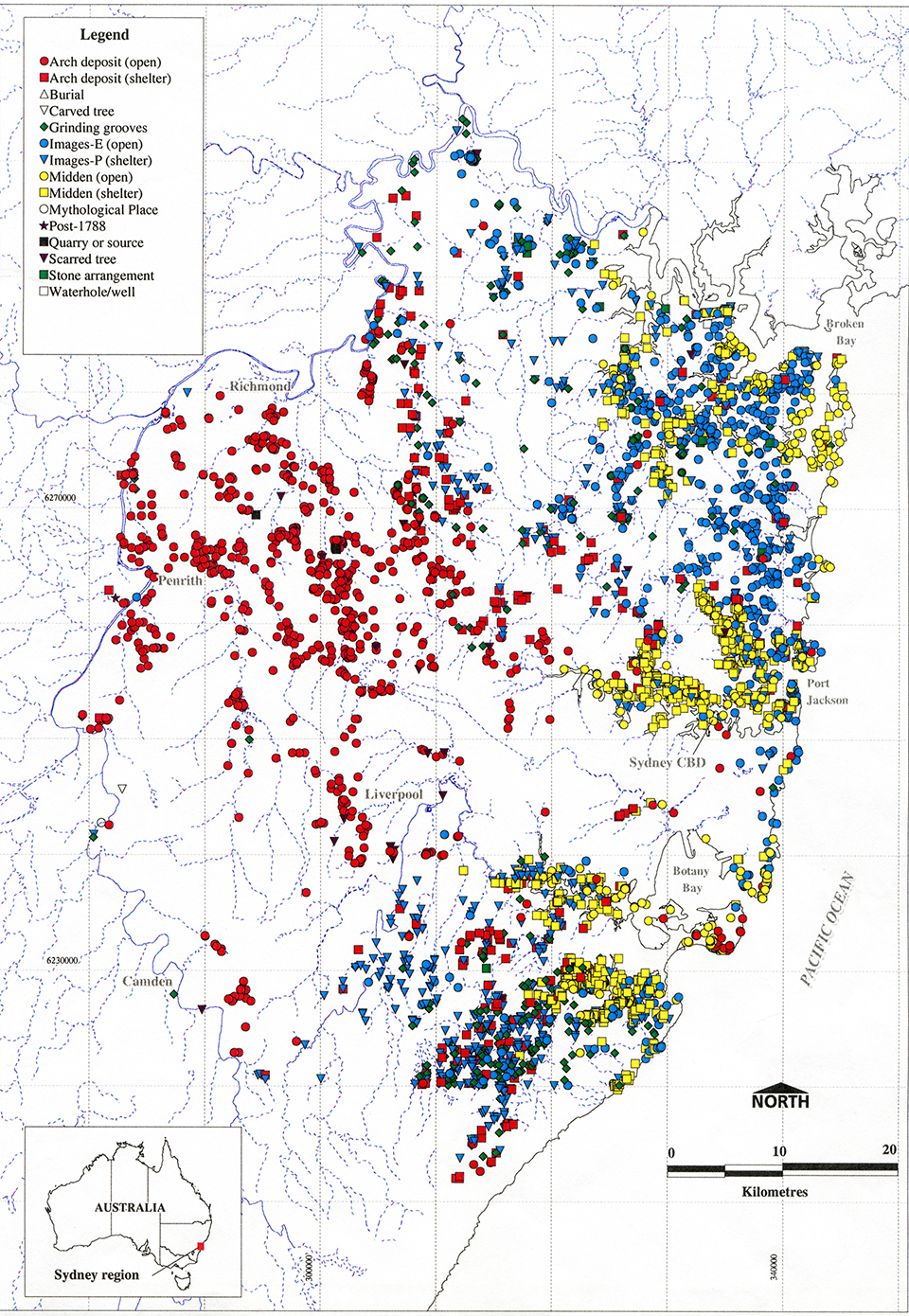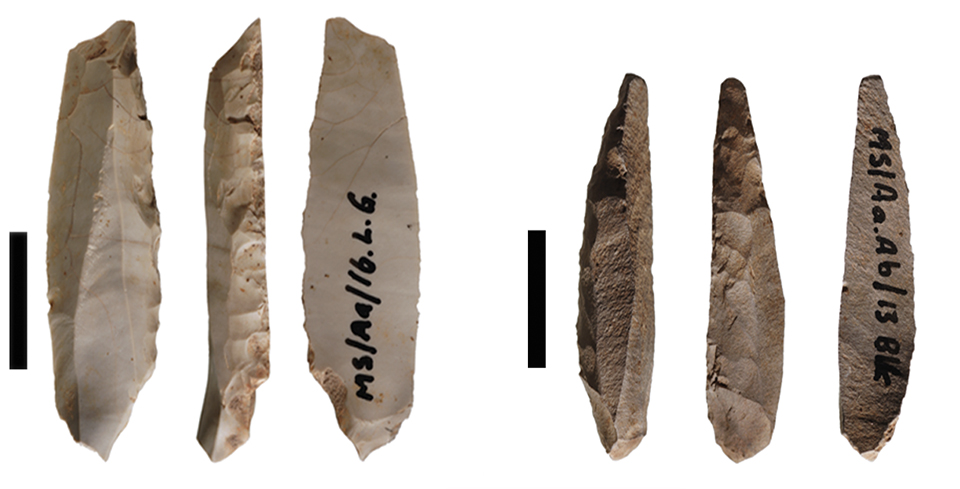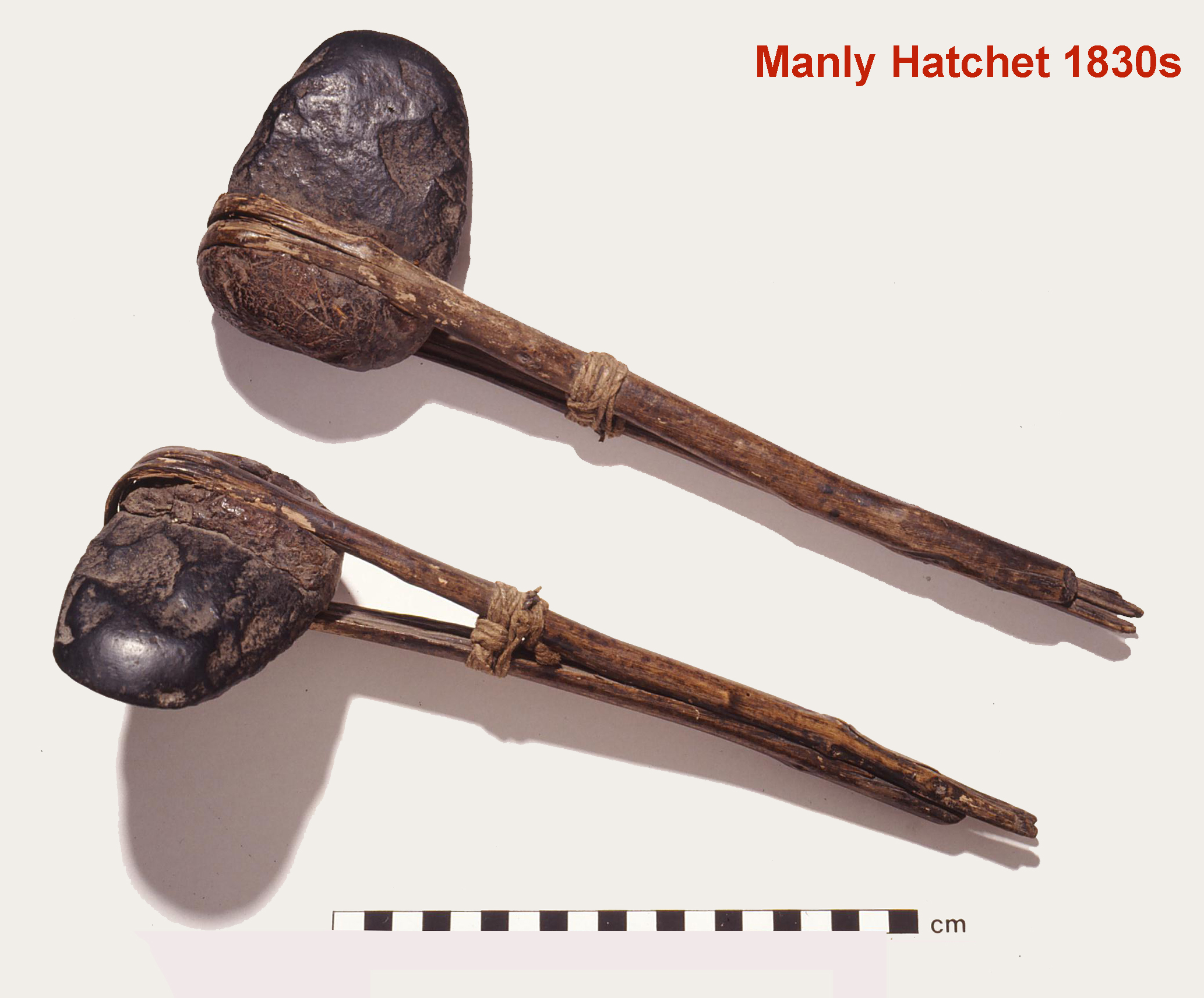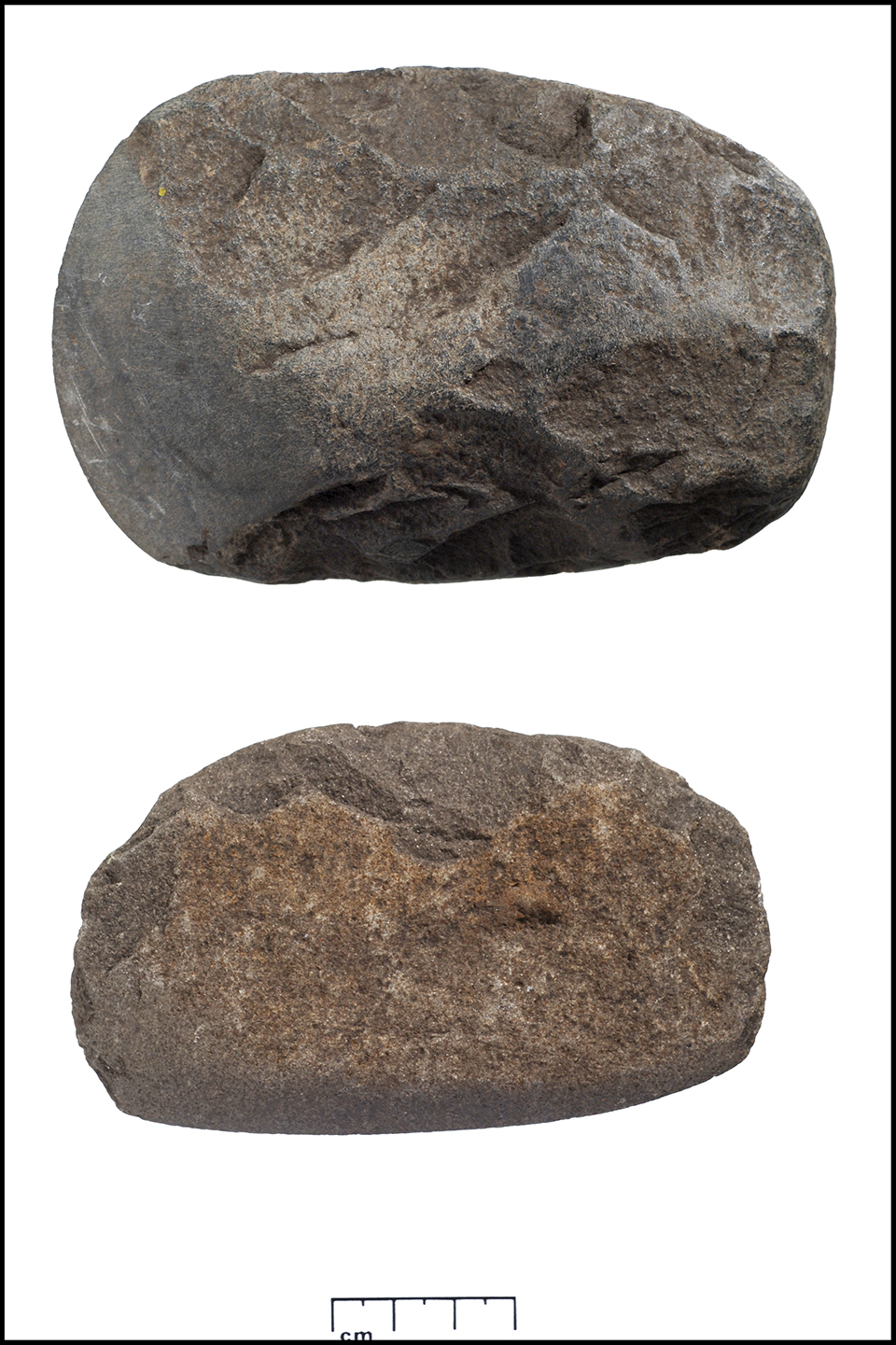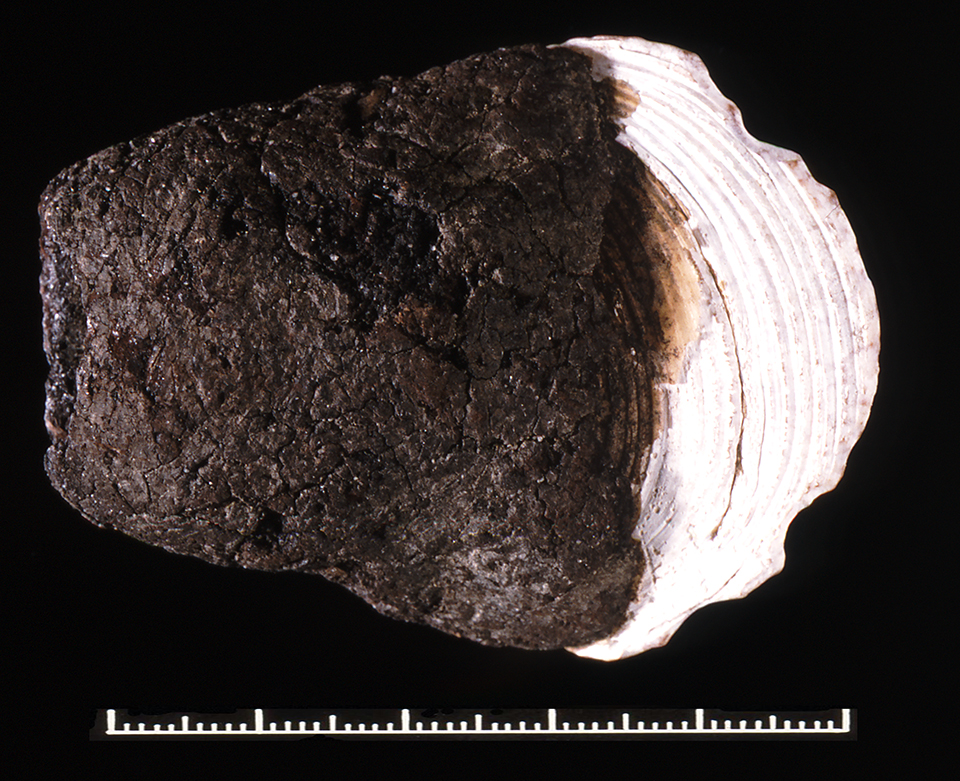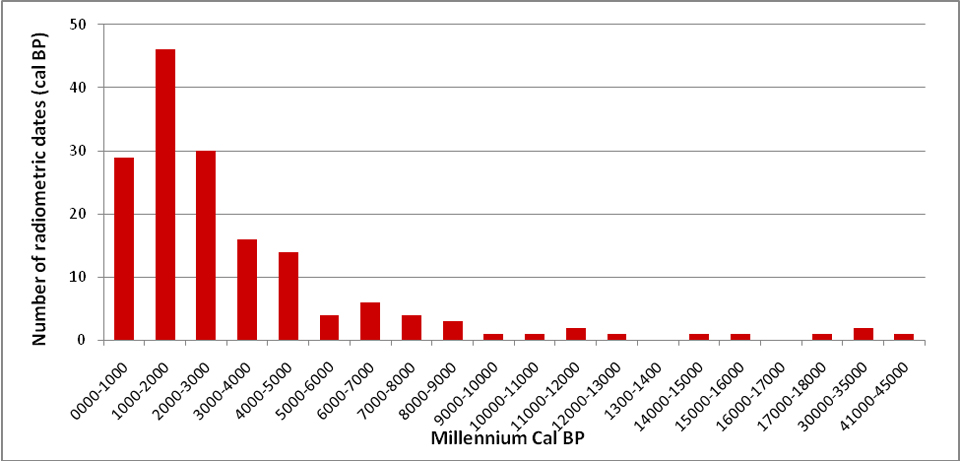The Dictionary of Sydney was archived in 2021.
Archaeological evidence of Aboriginal life in Sydney
Citation
Persistent URL for this entry
To cite this entry in text
To cite this entry in a Wikipedia footnote citation
To cite this entry as a Wikipedia External link
Archaeological evidence of Aboriginal life in Sydney
Today, [media]the Sydney region has a large Aboriginal population, many of whom are descendants of the original inhabitants who lived here when Captain Cook visited in 1770 and the First Fleet arrived in 1788. There is much historical information about the people who lived here when the British arrived – about their way of life, the foods they ate, the tools, weapons and equipment they used. [1] There is also some information about their belief systems and religious ceremonies, including those associated with the engraved and painted images found on rock-platforms and in rock-shelters respectively. [media]There are also many historical [media]images that portray Aboriginal people in a variety of contexts, but only a limited number of the implements, weapons and other items of material culture (such as spears, shields, clubs) that were collected in the very early years of the colony survive. [media]These are mainly in overseas museums, for example in England and Russia, with few in Australia. [2]
The people gained their food by hunting, fishing and gathering, and their foods came from land and marine animals, birds as well as plants. To obtain foods available in different locations and different seasons, people were relatively mobile. They lived in shelters made from bark and other plant materials as well as sandstone rock-shelters.
What is archaeological evidence?
For Aboriginal life prior to 1770, there is no documentary evidence, and it is archaeological evidence (the archaeological record) that must be examined to find out about the lives, activities and material culture of people who lived in this land for thousands of years. The archaeological record is important, as it reveals that many aspects of Aboriginal life changed over time, and people did not always use the same tools and subsistence technologies that were observed when the British arrived. In addition, it provides additional details about some aspects of life that are not described in the historical documents – for example, the range of land and marine animals eaten, and the raw materials used in making tools and weapons.
Archaeological evidence consists of the physical remains left behind after people have been, for example, camping, making tools, weapons and equipment, processing and eating food, and creating representations of animals, humans and other beings. The places where such evidence is found are called archaeological sites.
Aboriginal archaeological sites
The archaeological evidence at Aboriginal sites is referred to by a variety of names depending principally on the sites' locations and contents. Their location is given as either 'open' or 'rock-shelter', and their contents are called: shell middens, archaeological deposits, stone artefact scatters, engraved images, pigment images, grinding grooves, abraded channels, water holes, stone quarries or sources, stone arrangements, burials, scarred trees, carved trees, mythological sites. [3] No physical evidence of ceremonial (bora) grounds is known to survive in the Sydney region. More than one type of evidence can occur at a site, for example, rock-shelters with deposit or midden can have pigment images on their walls and ceilings; rock-platforms with engraved images often also have grinding grooves.
Sydney is extremely fortunate in having such a diverse range of archaeological sites in which evidence of past Aboriginal activities survives. It has survived because of the region's sandstone geology with its rock-shelters and rock-platforms which formed the location of many Aboriginal activities, and its coastal location with ocean and estuarine shorelines along which hundreds if not thousands of middens accumulated.
More than 50 per cent of the recorded sites have archaeological deposits and shell middens, with the next most common being engraved and pigment images and grinding grooves. These are the sets of evidence used most commonly by archaeologists in describing Aboriginal life and material culture before the 1770s, and are focussed on below.
Archaeological deposits and shell middens
Although historically people were observed living in shelters made of bark and other plant materials, no such structures survive in the Sydney region today. Sites are identified as campsites if they have large assemblages of stone artefacts which contain tools and artefact types that indicate tools were manufactured as well as used in that location. If the artefacts are embedded in sediment with depth, the site is said to have 'archaeological deposit'; such sites may also have faunal remains if preservation conditions allow. Rock-shelters are more likely than open locations to have deep stratified deposits and to contain bone and shell tools and faunal remains as well as stone artefacts.
[media]In open locations, where artefacts are exposed on the ground surface through natural or human-induced erosion, such as on the Cumberland Plain, the term 'stone artefact scatter' is often used; such sites rarely have faunal remains. Sites which comprise only a few stone tools or artefacts may have been associated with daytime hunting or butchering activities, or have been overnight transit camps as small groups moved from one area to another.
The [media]term 'shell midden' (or 'midden') is used in contexts where shell is the major visible component. Some shell middens consist of shell only; these may be places where shellfish were processed and the meat taken elsewhere to be eaten or used as bait (burley) in fishing. Archaeological deposits and shell middens can occur in rock-shelters as well as open locations.
[media]Shell middens can be deep and stratified whether in rock-shelters or open locations, and the shell provides an excellent preservational medium for other organic materials to survive. However, organic materials such as shell and animal bone rarely survive longer than 3,000 years in the Sydney's acidic sandstone environment. Thus, in lower levels of deep deposits representing earlier periods of time, whether in the open or rock-shelters, stone artefacts are often the only surviving evidence of human occupation.
Engraved and pigment images (rock art)
The [media]most common subjects depicted in both the engraved images and the pigment images are men and women, hands, footprints, ancestral beings or supernatural beings, kangaroos/wallabies, dingos, wombats, echidnas, macropod and emu tracks, fish, eels, sharks, dolphins, whales, sun-fish, turtles, snakes, lizards, emus, lyre birds, brush turkey; shields, boomerangs, axes, single barbed and multi-pronged spears), clubs and dilly bags (baskets). European sailing ships have been recorded at a small number of sites, as well as a clay pipe, bulls and a skirted female.
[media]In the Sydney region, engraved images (rock engravings) occur principally on open horizontal sandstone platforms, though they are occasionally found in rock-shelters and on vertical sandstone faces. The 'scalloped' edge of the lines forming the [media]engraved images suggests they were created by first making a series of small pits which were subsequently abraded or reworked on several occasions; [4] a technique now referred to as 'conjoined-puncturing'. [5] The type of implement used to make the engraved outlines is not known as it was not until the late nineteenth century that non-Aboriginal people reported seeing engraved images being made when, on one occasion, a metal tool was used. [6]
[media]Pigment images were created using dry (drawings) or wet (paintings, stencils and prints) pigment. They occur only in rock-shelters where they are protected from the weather, and can be found anywhere on the walls and ceilings. They are mainly black charcoal, and red and white, and occasionally yellow, pigment.
Unfortunately, the original cultural significance of these images has not been retained in oral histories and was not recorded by the first British colonists. [7] They may have been created for secular purposes as well as ceremonial/ritual contexts: to ensure success in hunting or fishing ventures; to teach or record, say, hunting and fishing strategies; to tell stories about past events (real or legendary); or to depict something the artist had seen. [8]
At present, except for the post-contact images such as sailing ships, dating the engraved and pigment images in the Sydney region has proved impossible, though superimposed pigment images have been used to propose sequences of different styles. [9] In adjacent regions, the most reliable results from attempts to date pigment images indicate ages of around 600 and 280 years for charcoal drawings in the New South Wales south coast. [10] Minimum ages for engraved images in two rock shelters have been obtained. In the Macdonald Valley, partially buried engravings were exposed during excavations. [11] Radiocarbon ages for the deposit adjacent to the engravings indicate they must be older than 2,800 years. In the Blue Mountains, a radiocarbon date form a mineral crust over an engraved bird track provided a minimum age of 1,790 years. [12]
Grinding grooves
[media]Grinding grooves are depressions which formed in the sandstone when an implement was being made; for example, as a piece of stone, wood or bone was rubbed on a rock surface to shape or sharpen an edge or create a point. Lozenge- or cigar-shaped grooves are interpreted as being formed during the making or resharpening of ground-edged stone implements – in particular the working edge of stone hatchet (axe) heads. Long, slender grooves are usually associated with sharpening wooden spear points or bone points. Circular or oval-shaped ground areas also occur and these may have formed during food processing or powdering ochre.
In the Sydney region, grinding grooves usually occur on sandstone immediately adjacent to a water source – rock pools or seepage zones on rock platforms, exposed bedrock in creek beds, and under drip-lines in rock-shelters. Dating grinding grooves, as with images, has also proved impossible as situations have not been found where grooves are buried with datable material in the soils above them. However, it is assumed that those identified as hatchet shaping/sharpening grooves will be less than 4,000 years old, as this is the date when ground hatchets (or fragments from them) first appear in dated stratified deposits and middens. Despite this limitation, their distribution contributes important information about land and resource use patterns. [13]
Burial sites
[media]Burial sites are locations where people were buried and where skeletal remains have been found. In the Sydney region, depending on their status, people were cremated or buried in a simple grave. Burials are often found in coastal shell middens and sand dunes. Carved trees were associated with some burials in the Picton–Narellan area. [14]
Ceremonial grounds
Ceremonial [media]grounds are locations at which important ceremonies and social functions took place, in particular the initiation of young men into manhood. In south-eastern Australia, ceremonial grounds usually had two circular areas connected by a path. Inside the rings, which were made of earth or stone, various rites were held, including tooth avulsion. Many groups had their own names for these ceremonial sites; the name ' bora', which is commonly used today, was originally the name used by the Gamilaroi (Kamilaroi) of western New South Wales.
Carved and scarred trees
[media]Carved trees have designs carved either into the wood or bark. Surviving examples are usually those in which the designs were carved into the wood. Designs were carved on trees around burial and ceremonial grounds. The designs were usually geometric patterns representing totemic affiliations. There are no living carved trees in the Sydney region today. [media]Scarred trees are classified separately from carved trees. They have scars where a section of bark or wood has been removed to make canoes, shields and baskets or to cut footsteps up the tree trunk to gain access to possums or honey in the tree tops.
Site distribution and site location patterns
[media]More than 5,000 archaeological sites with evidence for a variety of Aboriginal activities have been recorded in the Sydney region (the land bounded by the coast on the east, by the Hawkesbury-Nepean River on the north and west, and by a line running east-west through Picton and Stanwell Park in the south).
These sites with their different types of evidence are not uniformly distributed across the land. Many are directly associated with specific environmental characteristics. For example, as stated above, shell middens are associated with estuarine and ocean shorelines. Rock-shelters with midden or deposit and/or images, engraved images and grinding grooves on rock-platforms, stone arrangements, abraded channels and waterholes are associated directly with sandstone. In addition, almost all of the recorded open middens are located directly on sandstone as they preserve best on that substrate. On the other hand, the Cumberland Plain is dominated by open deposits with stone artefacts because of its shale geology and the rarity of outcropping sandstone.
In 2001, analysis of the locational contexts of middens and deposits in the Port Jackson catchment found that over half of them are in the foreshore zone, within 10 metres of high water level. Only three had been reported on the ridge-tops, while just under a quarter are on ridge-sides. Locational details for the remaining 15 per cent indicate they are within either the foreshore zone or lower part of the ridge-side. Over half (61 per cent) of the middens and a high proportion (80 per cent) of the archaeological deposits are in rock-shelters rather than in open situations. Comparison of these figures with survey projects in undeveloped bushland to the north (Bouddi and Spencer [15]) suggests that the proportion of middens and deposits on the ridge-sides in the Port Jackson catchment may be under-represented because of destruction by suburban and industrial developments. These studies suggest that many activities, including those relating to tool-making and food-processing which happened at base campsites, took place close to the estuarine and freshwater waterways as well as marine shorelines.
Evidence from excavated archaeological sites
The evidence from excavated sites (deposits and middens) provides data in a chronological framework and demonstrates the cultural changes that occurred over time in the Sydney region. Three implements that provide evidence of changing technology are backed artefacts, ground-edged hatchets and shell fish-hooks.
Stone artefacts are the most ubiquitous items in archaeological sites as they are the most durable. The term 'stone artefacts' includes pieces used as tools as well as the discarded products from manufacturing, such as unused flakes and flaked pieces and cores. [16]
Backed artefacts – changing technology
[media]Backed artefacts – often divided into categories called Bondi points, geometric microliths and Elouera – are amongst the most discussed stone artefacts in the Sydney region, where the most common form is the Bondi point. They are made on a flake which has been shaped/retouched by a technique known as 'backing', in which small flakes are removed along one edge of the flake to create a thick, steep-angled 'back'. [17] These backed artefacts are usually less than 30 mm long, but can be up to 80 mm in length.
[media]There are no historical descriptions of backed artefact manufacture or use and there has been much debate and speculation about their use. The most common view has been that they were barbs and/or tips on spears, but since the late 1970s microscopic use-wear and residue analyses have enabled convincing inferences to be made showing they had a range of uses. For example, Robertson's [18] integrated residue and use-wear analysis of backed artefacts from Lapstone Creek rock-shelter, near Emu Plains, concluded that 46 of 50 Bondi points functioned as incising and/or drilling, scraping and cutting tools, and were used in working wood and bone and processing non-woody plants. Many had resin adhering indicating they were once hafted.
In contrast to these domestic tasks, backed artefacts embedded in the skeleton known as 'Narrabeen Man' have been interpreted as 'spear armatures'. [19] They were obviously from a weapon that was thrown or thrust at the man causing his death. Thus, as with other tools, backed artefacts were multi-functional and multi-purpose components in a range of different tools. [20]
Backed artefacts initially appeared in the Sydney basin in very small numbers around 8,500 years ago. [21] After a period of gradual increase, their production increased dramatically – an event referred to by archaeologists as the 'backed artefact proliferation'. [22] This event appears to have occurred almost simultaneously across the region between 4,000 and 3,500 years ago. Numbers remain high for about the next 2,500 years, and backed artefacts are found in numerous sites and are recorded in large numbers in individual sites dating to this period. In contrast to the proliferation event, the subsequent loss of backed artefacts seems to have occurred at different times and rates in different areas. In the coastal zone and sandstone country of the Sydney region they disappeared or lessened in number around 1,500 to 1,400 years ago, but in some hinterland areas they continued in use until at least 340 years ago. [23] By the time of British colonisation, they were either not used or used so little that they were never recorded by the first British colonists.
Recent explanatory models for the proliferation in backed artefact production is that it was a response to climate change. During the period over which the proliferation lasted the climate regime was cooler and drier than at any other time in the last 12,000 years, combined with intensified El Niño–Southern Oscillation (ENSO) climatic patterns. One hypothesis maintains that backed artefacts had a symbolic value within Aboriginal societies that was advantageous at this time as territories reorganised because of increased resource patchiness resulting from the intensified ENSO regime. [24] Other explanations posit that backed artefact use alleviated an accelerated level of subsistence risk brought about by the onset of cooler and drier climate conditions combined with ENSO-intensified climatic pattern. [25] However, these hypotheses are merely different versions of an adaptive model in which Aboriginal people responded to climatic change by increasing backed artefact manufacture. [26]
Such models are based principally on the chronological similarity between the start of the backed artefact proliferation and onset of changed climatic conditions. While this correlation suggests Aboriginal people adjusted to climatically modified environmental conditions by altering their technological and tool use strategies, no specific circumstances have yet been identified for which increasing backed artefact production would be advantageous, such as a change in the abundance of a particular food resource.
Ground-edged hatchets
Ground-edged [media]hatchets (often called axes [27]) characteristically have a cutting edge created by two ground surfaces. In historical times they were hafted with a wooden wrap-around handle, and used for chopping, particularly wood, but also in butchering animals and warfare. [media]Some ground-edged implements have the ground edge along a lateral margin; these are usually referred to as Bulga knives.
In south-eastern Australia, evidence of ground-edged implements first appears in archaeological sites in levels dated to about 4,000 years ago. Then, about 1,200–1,000 years ago they increase in number.
Shell tools
[media]Shell was used to make fish-hooks as well as being used for cutting and scraping tools in processing foods and raw materials. The fish-hooks, which were only used along the coast and estuaries, were used with a line of two-ply twine made from plant fibres.
Shell fish-hooks are the most numerous shell [media]tools in coastal archaeological collections. They are fascinating objects for a variety of reasons. Firstly, because the historical records indicate there was a division of labour in fishing activities. Shell fishhooks were made and used only by the women in hook-and-line fishing from bark canoes, whereas men used multi-pronged spears to fish from rock platforms and canoes. Secondly, the historical records do not describe how the shell fish-hooks were made; this is learnt from the archaeological record. Thirdly, the archaeological record indicates they are a relatively late introduction to the coastal tool kit of New South Wales, around 1,000-900 years ago, and that they have a restricted geographical distribution from Port Macquarie (Point Plomer) on the north coast to the New South Wales–Victorian border in the south. [28]
How shell fish-hooks came to be used in southern coastal New South Wales is not known. Whether they were independently invented, or the idea or objects came from the north, or even from the east, is not clear. [29] If they spread southward from northern Queensland, where the most southerly occurrence is Keppel Island, [30] why were they not adopted by coastal groups between Keppel Island and Port Macquarie – a distance of some 1,000 kilometres? An eastern origin involves sea voyaging with people from the Pacific. Recent archaeological investigations indicate New Zealand and the Cook Islands were occupied initially by Polynesians between 600 and 800 years ago and that Norfolk Island was also occupied for a short time during that period. [31] These ages are somewhat later than the appearance of shell fish-hooks along the New South Wales coast, but they show that long-distance ocean voyages were being made in the western Pacific in this general period and support a proposition that shell fish-hooks could have arrived with a group of Pacific voyagers 900 to 1,000 years ago.
The archaeologically documented appearance of shell fish-hooks indicates that the late eighteenth and early nineteenth century descriptions of many aspects of Aboriginal life in Sydney cannot be taken back further than about 1,000 or 900 years. It is well documented that in 1788 fishing with hook and line was the specific task of women. It is not known whether this was the case from the time they were first adopted along the New South Wales south and central coast. However, it can be said that scenes of women fishing with hook and line from canoes as depicted in the early colonial images would not have been seen more than 1,000 or 900 years ago.
Charcoal, shell, sediments and radiometric dates
Charcoal, shells and sediments in the archaeological deposits and shell middens have provided radiometric dates which allow estimates to be made of the dates when a site was first used and/or when subsequent events took place at the site.
At least 164 radiometric dates, determined through radiocarbon (C14), thermoluminescence (TL) or optically stimulated luminescence (OSL) dating, have been obtained for some 64 sites in the Sydney region. Open deposits have been radiometrically dated less often than rock-shelter deposits as there is frequently no charcoal present, and/or there is greater uncertainty about the origin of any charcoal present, and/or the association between the dated material and cultural evidence (such as stone artefacts) is uncertain. The earliest accepted age for a habitation site in the Sydney region is 14,000 years before the present (BP) for a rock-shelter known as Shaws Creek K2, adjacent to the western side of the Nepean River. Questions have been raised about the 40,000 years BP radiocarbon age for stone artefacts from the Cranebrook Terrace near Penrith, [32] and the date of 30,000 years BP at Parramatta. [33]
These [media]graphs[media] showing the number of radiocarbon ages in successive millennium (top) and the number of sites first occupied in each millennium (bottom). The majority of dates in each graph are less than 3,000 years old. However, whether this patterning reflects demographic/population change, the lack of preservation of early sites or changes in land use and resource patterns, is open to much debate. Interpreting graphs such as these is difficult as sites are excavated and radiocarbon dated by archaeologists for a variety of reasons. In addition some dates represent short-term events (for example, the hearths at Prince of Wales Hospital), and for large area open sites it is often not known whether the dates obtained reflect the earliest occupation, the full period of occupation of the site or a recent occupation. Additional dates for sites excavated in the future may well change the configuration of the graphs substantially.
The graphs do, however, along with site distribution maps, provide impressions of what parts of the country are currently known to be occupied in different periods of time. As such they can indicate gaps in our knowledge and provide the basis for future research questions about Aboriginal occupation of different parts of the region.
Conclusions
Only a small portion of the available archaeological evidence is discussed above, but it illustrates the richness of the Sydney region's archaeological record. Such evidence reveals the dynamic and changing nature of Aboriginal life over the millennia that people have lived in the Sydney region. It also demonstrates some of the small number of practical and often multi-purpose tools, weapons and equipment that formed the tool kit of people who lived in the Sydney region in the near and distant past.
References
V Attenbrow, 'Aboriginal fishing on Port Jackson, and the introduction of shell fish-hooks to coastal New South Wales, Australia', in P Hutching, D Lunney, and D Hochuli (eds), The Natural History of Sydney, Royal Zoological Society of New South Wales, Mosman NSW, 2010, pp 16–34
V Attenbrow, Sydney's Aboriginal Past: Investigating the Archaeological and Historical Records, 2nd edition, University of New South Wales Press, Sydney, 2010
V Attenbrow, What's Changing? Population Size or Land-Use Patterns? The Archaeology of Upper Mangrove Creek, Sydney Basin, Terra Australis 21, Pandanus Books, ANU, Canberra, 2004
V Attenbrow, 'The role of marine resources in the diet of pre-colonial Aboriginal people and land use patterns around Port Jackson, Sydney, New South Wales', in N Bicho, J Haws and LG Davis (eds), Trekking the Shore: Changing Coastlines and the Antiquity of Coastal Settlement, Springer, 2011, pp 463–491
V Attenbrow, G Robertson and P Hiscock, 'The changing abundance of backed artefacts in south-eastern Australia: a response to climate change?', Journal of Archaeological Science, vol 36, no 2009, pp 2765–70
D Collins, An Account of the English Colony in New South Wales, vol 1, BH Fletcher (ed), T Cadell Jun. & W Davies, The Strand, London, 1798, republished by AH and AW Reed in association with Royal Australian Historical Society, Sydney, 1975
RJ Etheridge, The Dendroglyphs, or Carved Trees of New South Wales, Memoirs of the Geological Survey of New South Wales, Ethnological Series no 3, NSW Geological Survey, Sydney, 1918
P Hiscock, Archaeology of Ancient Australia, Routledge, New York, 2008
G Karskens, The Colony: A History of Early Sydney, Allen and Unwin, Sydney, 2009
J McDonald, Dreamtime Superhighway. An Analysis of Sydney Basin Rock Art and Prehistoric Information Exchange, Terra Australis 27, ANU EPress, Canberra, 2008
T Popp, N Popp and B Walker, Footprints on Rock: Aboriginal Art of the Sydney Region, Metropolitan Local Aboriginal Land Council, Redfern, Sydney, 1997
P Stanbury and J Clegg, A Field Guide to Aboriginal Rock Engravings with special reference to those around Sydney, Sydney University Press in association with Oxford University Press Australia, Sydney, 1990
PSC Taçon, M Kelleher, G King and W Brennan, '"Eagle's Reach": A focal point for past and present social identity within the Northern Blue Mountains World Heritage Area, Australia', in I Domingo Sanz, D Fiore and SK May (eds), Archaeologies of Art. Time, Place and Identity, Left Coast Press Walnut Creek, California, USA, 2008, pp 195–214
P Vinnicombe, 'Single sites or site complexes? A case study from north of the Hawkesbury, New South Wales', in S Sullivan and S Bowdler (eds), Site Surveys and Significance Assessment in Australian Archaeology, The Department of Prehistory, RSPacS, ANU, Canberra, 1984, pp 107–18
Notes
[1] V Attenbrow, Sydney's Aboriginal Past: Investigating the Archaeological and Historical Records, 2nd edition, University of New South Wales Press, Sydney, 2010; G Karskens, The Colony: A History of Early Sydney, Allen and Unwin, Sydney, 2009
[2] V Attenbrow, Sydney's Aboriginal Past: Investigating the Archaeological and Historical Records, 2nd edition, University of New South Wales Press, Sydney, 2010, p 86
[3] V Attenbrow, Sydney's Aboriginal Past: Investigating the Archaeological and Historical Records, 2nd edition, University of New South Wales Press, Sydney, 2010, pp 48–49; and pp 203–08 for definitions in glossary; V Attenbrow, What's Changing? Population Size or Land-Use Patterns? The Archaeology of Upper Mangrove Creek, Sydney Basin, Terra Australis 2, Pandanus Books, ANU, Canberra, 2004, pp 37–49
[4] AP Elkin, 'The origin and interpretation of petroglyphs in south-east Australia', Oceania vol 22, no 2, 1949, pp 119–57; JF Mann, 'Notes on the Aborigines of Australia, Paper presented at meeting on the 16th August 1883', Proceedings of the Geographical Society Australasia, NSW and Victorian Branches (1st session, 1883–84) vol 1, pp 27–63; RH Mathews, 'The Aboriginal rock pictures of Australia', Proceedings and Transactions of the Royal Geographical Society of Australasia, Queensland Branch, vol 10, 1895, pp 146–70; RH Mathews, Notes on the Aborigines of New South Wales, Government Printer, Sydney, 1907, p 24
[5] P Stanbury and J Clegg, A Field Guide to Aboriginal Rock Engravings with special reference to those around Sydney, Sydney University Press in association with Oxford University Press Australia, Sydney, 1990, pp 119–20
[6] RH Mathews, 'Rock carving by the Australian Aborigines', Proceedings of the Royal Society of Queensland vol 12, 1897, pp 97–8, Plate 8
[7] T Popp, N Popp and B Walker, Footprints on Rock, Aboriginal Art of the Sydney Region, Metropolitan Local Aboriginal Land Council, Redfern, Sydney, 1997, p 8
[8] V Attenbrow, Sydney's Aboriginal Past: Investigating the Archaeological and Historical Records, 2nd edition, University of New South Wales Press, Sydney, 2010, pp 144–51; RH Mathews, 'The rock paintings and carvings of the Australian Aborigines', Journal of the Anthropological Institute of Great Britain and Ireland vol 25, no 1, 1895, pp 145–63. See R Layton, Australian Rock Art: A New Synthesis, Cambridge University Press, Cambridge UK, 1992, pp 71–75 for discussion about contemporary views on the purpose of pigment images in Arnhem Land
[9] J Clegg, 'Comments, FD McCarthy's rock art sequences: a matter of clarification', Rock Art Research vol 5, no 1, 1988, pp 19–22; J Cox, L Maynard and JVS Megaw, 'The excavation of a rock shelter at Audley, Royal National Park, New South Wales', Archaeology and Physical Anthropology in Oceania vol 3, no 2, 1968, pp 94–104 ; R Layton, Australian Rock Art: A New Synthesis, Cambridge University Press, Cambridge UK, 1992, pp 10, 220; FD McCarthy, 'A remarkable ritual gallery of cave paintings in eastern New South Wales', Records of the Australian Museum, 25(7), 1961, pp 115–20; FD McCarthy, 'Rock art sequences: a matter of clarification', with comments, Rock Art Research vol 5, no 1, 1988, pp 16–42; FD McCarthy, 'Rock engravings of the Sydney-Hawkesbury district, Part 2: some important ritual groups in the County of Cumberland', Records of the Australian Museum, vol 24, no 14, 1959, 203–16; FD McCarthy, 'Schematisation in eastern and northern Australian rock art', in PJ Ucko (ed), Form in Indigenous Art, pp 403–04, Australian Institute of Aboriginal Studies, Canberra, 1977; J McDonald, 'Shelter rock-art in the Sydney Basin – a space-time continuum: exploring different influences on stylistic change', in C Chippindale and PSC Taçon (eds), The Archaeology of Rock-Art, Cambridge University Press, Cambridge UK, 1998, pp 319–35
[10] J McDonald, Dreamtime Superhighway, An Analysis of Sydney Basin Rock Art and Prehistoric Information Exchange, Terra Australis 27, ANU EPress, Canberra, 2008, pp 214–16; J McDonald, 'Shelter rock-art in the Sydney Basin – a space-time continuum: exploring different influences on stylistic change', in C Chippindale and PSC Taçon (eds), The Archaeology of Rock-Art, Cambridge University Press, 1998, pp 319–35; J McDonald, K Officer, T Jull, D Donahue, J Head and B Ford, 'Investigating 14C AMS: dating prehistoric rock art in the Sydney sandstone basin', Australia, Rock Art Research, vol 7, 1990, pp 83–92
[11] J McDonald, Dreamtime Superhighway, An Analysis of Sydney Basin Rock Art and Prehistoric Information Exchange, Terra Australis 27, ANU EPress, Canberra, 2008, pp 98–99, 135–35, Table 6.11 (2750±220, ANU-6215); J McDonald, 'On a clear day, you can see Mount Yengo, Or: investigating the archaeological manifestations of culturally significant foci in the prehistoric landscape', in J Steinbring, A Watchman, P Faulstich and PSC Taçon (eds), Time and Space, Australian Rock Art Research Association, Melbourne, 1993, pp 84–91
[12] PSC Taçon, M Kelleher, W Brennan, S Hooper and D Pross, 'Wollemi petroglyphs, New South Wales, Australia, An unusual assemblage with rare motifs', Rock Art Research vol 23, no 2, 2006, pp 227–38, 1900±220 years BP, OZG-848; PSC Taçon, M Kelleher, G King and W Brennan, '"Eagle's Reach": A focal point for past and present social identity within the Northern Blue Mountains World Heritage Area, Australia', in I Domingo Sanz, D Fiore and SK May (eds), Archaeologies of Art, Time, Place and Identity, Left Coast Press Walnut Creek, California USA, 2008, pp 195–214. See also discussions on the antiquity of Australian rock art in R Layton, Australian Rock Art: A New Synthesis, Cambridge University Press, Cambridge, UK, 1992, pp 212–28, and NR Franklin, Explorations of Variability in Australian Prehistoric Rock Engravings, BAR International Series 1318, Archaeopress, Oxford, 2004, pp 8–18
[13] See, for example, V Attenbrow, 'Habitation and land use patterns in the Upper Mangrove Creek catchment, NSW central coast, Australia', in J Specht, V Attenbrow, and R Torrence (eds), Shaping the Future Pasts: Papers in Honour of J. Peter White, Australian Archaeology, vol 57, 2003, pp 20–31
[14] RJ Etheridge, The Dendroglyphs, or Carved Trees of New South Wales, Memoirs of the Geological Survey of New South Wales, Ethnological Series No 3, NSW Geological Survey, Sydney, 1918, Plate 16 (1, 2)
[15] P Vinnicombe, 'Predilection and Prediction: A Study of the Aboriginal Sites in the Gosford–Wyong Region', Unpublished report to the NSW National Parks and Wildlife Service, 1980; P Vinnicombe, 'Single sites or site complexes? A case study from north of the Hawkesbury, New South Wales', in S Sullivan and S Bowdler (eds), Site Surveys and Significance Assessment in Australian Archaeology, Department of Prehistory, Research School of Pacific Studies, Australian National University, Canberra, 1984, pp 107–18
[16] For definitions of terms, see glossary in V Attenbrow, Sydney's Aboriginal Past: Investigating the Archaeological and Historical Records, 2nd edition, University of New South Wales Press, Sydney, 2010, pp 203–08
[17] P Hiscock, 'Bondaian technology in the Hunter Valley, New South Wales', Archaeology in Oceania, vol 28, no 2, 1993, 65–76]
[18] G Robertson, 'Aboriginal use of backed artefacts at Lapstone Creek rock-shelter, New South Wales: an integrated residue and use-wear analysis', Technical Reports of the Australian Museum On line vol 23, no 7, 2011, pp 83–101
[19] JJ McDonald, D Donlon, JH Field, RLK Fullagar, JB Coltrain, P Mitchell and M Rawson, 'The first archaeological evidence for death by spearing in Australia', Antiquity vol 81, 2007, pp 877–85
[20] G Robertson, V Attenbrow and P Hiscock, 'The multiple uses of Australian backed artefacts', Antiquity, vol 83, 2009, pp 296–308
[21] V Attenbrow, What's Changing? Population Size or Land-Use Patterns? The Archaeology of Upper Mangrove Creek, Sydney Basin, Terra australis No 2, Pandanus Books, Australian National University, Canberra, 2004, p 74; P Hiscock, Archaeology of Ancient Australia, Routledge, New York, 2008, p 154
[22] P Hiscock, 'Pattern and context in the Holocene proliferation of backed artefacts in Australia', in RG Elston and SL Kuhn (eds), Thinking Small: Global Perspectives on Microlithization, Archaeological Papers of the American Anthropological Association (AP3A) no 12, 2002, pp 163–77
[23] Jo McDonald CHM Pty Ltd, Salvage Excavation of Six Sites along Caddies, Second Ponds, Smalls and Cattai Creeks in the Rouse Hill Development Area, New South Wales, Australian Archaeological Consultancy Monograph Series no 1, 2005, p 152; JP White and JF O'Connell, A Prehistory of Australia, New Guinea and Sahul, Academic Press, Sydney, 1982, p 125
[24] See, for example, B David and H Lourandos, 'Rock art and socio-demography in northeastern Australian prehistory', World Archaeology, vol 30, no 2, 1998, pp 193–219
[25] See, for example, V Attenbrow, What's Changing? Population Size or Land-Use Patterns? The Archaeology of Upper Mangrove Creek, Sydney Basin, Terra Australis 2, Pandanus Books, ANU, Canberra, 2004; V Attenbrow, G Robertson and P Hiscock, 'The changing abundance of backed artefacts in south-eastern Australia: a response to climate change?', Journal of Archaeological Science, vol 36, 2009, pp 2765–70; P Hiscock, 'Blunt and to the point: changing technological strategies in Holocene Australia', in I Lilley (ed), Archaeology of Oceania: Australia and the Pacific Islands, Blackwell, 2006, pp 69–95; P Hiscock, 'Pattern and context in the Holocene proliferation of backed artefacts in Australia', in RG Elston and SL Kuhn (eds), Thinking Small: Global Perspectives on Microlithization, Archaeological Papers of the American Anthropological Association (AP3A), no 12, 2002, pp 163–77
[26] V Attenbrow, G Robertson and P Hiscock, 'The changing abundance of backed artefacts in south-eastern Australia: a response to climate change?', Journal of Archaeological Science, vol 36, 2009, pp 2765–70
[27] A hatchet is much smaller than an axe and is used with one hand in contrast to an axe which requires two hands. In Australia, the small ground-edged implements with wrap-around handles were technically hatchets
[28] V Attenbrow, 'Aboriginal fishing on Port Jackson, and the introduction of shell fish-hooks to coastal New South Wales, Australia', in P Hutching, D Lunney, and D Hochuli (eds), The Natural History of Sydney, Royal Zoological Society of New South Wales, Mosman NSW, 2010, pp 16–34; V Attenbrow, R Fullagar, and C Szpak, 'Stone files and shell fish hooks in southeastern Australia', in R Fullagar (ed), A Closer Look: Recent Australian Studies of Stone Tools, Archaeological Computing Laboratory, School of Archaeology, University of Sydney, 1998, pp 127–48
[29] I Walters, 'Fish hooks: evidence for dual social systems in southeastern Australia?', Australian Archaeology, vol 27, 1988, pp 98–114
[30] M Rowland, 'The Keppel Islands – "a 3000 year" event revisited', in J Hall, IJ McNiven (eds), Australian Coastal Archaeology, ANH Publications, Department of Archaeology and Natural History, Research School of Pacific Studies, Australian National University, Canberra, 1999, pp 141–55 (based on radiocarbon age of 1520±50 years BP ANU 2489 for a shell sample); I Walters, 'Fish hooks: evidence for dual social systems in southeastern Australia?', Australian Archaeology, vol 27, 1988, pp 98–114
[31] A Anderson, T Higham, and R Wallace, 'The radiocarbon chronology of the Norfolk Island archaeological sites', in A Anderson and P White (eds), The Prehistoric Archaeology of Norfolk Island, Southwest Pacific, Records of the Australian Museum, Supplement 27, 2001, pp 33–42; J Specht, 'Additional evidence for pre-1788 visits by Pacific Islanders to Norfolk Island, south-west Pacific', in J Specht (ed), FD McCarthy, Commemorative Papers (Archaeology, Anthropology, Rock Art), Records of the Australian Museum, Supplement 17, 1993, pp 145–57
[32] GC Nanson, RW Young and ED Stockton, 'Chronology and palaeoenvironment of the Cranebrook Terrace (near Sydney) containing artefacts more than 40 000 years old', Archaeology in Oceania, vol 22, no 2, 1987, pp 72–78
[33] Jo McDonald CHM Pty Ltd, Archaeological Salvage Excavation of Site RTA-G1, 109–113 George Street, Parramatta, New South Wales, Report to Landcom, 2005, pp 107–125, Table 58



